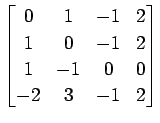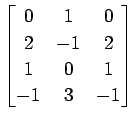3.23 演習問題 〜 1 次独立なベクトルの最大個数
問 3.84 (1 次独立なベクトルの最大個数)
次のベクトルの組の 1 次独立なベクトルの最大個数と
そのときの組合わせのひとつを示せ.
また,それ以外の 1 次従属なベクトルを
1 次独立なベクトルの 1 次結合で表わせ.
(1)
 ,
,
![]() (2)
(2)
 ,
,
 ,
,
![]() (3)
(3)
 ,
,
 ,
,
![]() ,
,

(4)
 ,
,
 ,
,
![]() ,
,
 (5)
(5)
 ,
,
![]() ,
,
![]() ,
,
 ,
,
![]() (6)
(6)

(7)
 ,
,
 ,
,
![]() (8)
(8)
 ,
,
 ,
,
 ,
,
![]()
(9)
 ,
,
 ,
,
 ,
,
 (10)
(10)
 ,
,
 ,
,
 ,
,
![]() ,
,

(11)
 ,
,
 ,
,
![]() ,
,
![]() ,
,
 ,
,
![]() (12)
(12)
 ,
,
![]() ,
,
![]() ,
,
![]() ,
,
![]()
(13)
 ,
,
![]() ,
,
 ,
,
 ,
,
 (14)
(14)
 ,
,
![]() ,
,
![]()
(15)
 ,
,
 ,
,
![]() (16)
(16)
 ,
,
 ,
,

(17)
 ,
,
 ,
,
![]() (18)
(18)
 ,
,
![]() ,
,
 ,
,
 ,
,
 .
.
(19)
 ,
,
![]() ,
,
 ,
,
 ,
,
![]() ,
,
![]() (20)
(20)
 ,
,
![]() ,
,
![]() .
.
![]() ,
,
![]() ,
,
![]()
(21)
 ,
,
![]() ,
,
![]()
(22)
![]() ,
, ![]() ,
,
![]() ,
, ![]() ,
, ![]() (23)
(23)
![]() ,
, ![]() ,
,
![]() ,
,
![]() ,
,
![]()
問 3.85 (1 次独立なベクトルの最大個数)
次の行列の列ベクトルの  次独立なベクトルの最大個数を述べよ.
また,行ベクトルの
次独立なベクトルの最大個数を述べよ.
また,行ベクトルの  次独立なベクトルの最大個数を述べよ.
次独立なベクトルの最大個数を述べよ.
(1)
 (2)
(2)
 (3)
(3)
 (4)
(4)

(5)
 (6)
(6)
 (7)
(7)

Kondo Koichi

平成18年1月17日